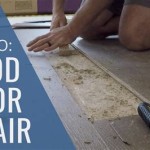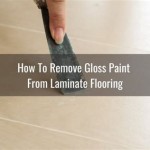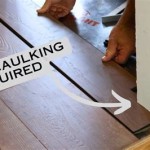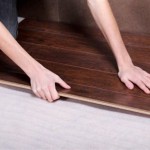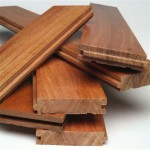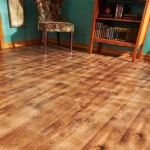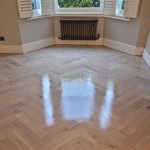How To Remove Duct Tape Residue From Wood Floor
Duct tape, lauded for its versatility and sticking power, often becomes a homeowner's temporary fix for various problems. However, its tenacious adhesive can leave behind a stubborn residue when removed from surfaces, particularly wood floors. Wood, being a porous and sometimes delicate material, requires careful handling during residue removal to avoid damage. This article provides a comprehensive guide on safely and effectively removing duct tape residue from wood floors, utilizing different methods and emphasizing preventative measures.
The challenge with duct tape residue lies in its composition. The adhesive is designed to bond strongly, and when the tape is peeled away, a portion of this adhesive can remain embedded in the wood's surface. This residue not only detracts from the floor's appearance but can also attract dirt and debris, making the problem worse over time. Attempting to simply scratch or scrape the residue off can easily damage the floor's finish, leading to costly repairs.
Before initiating any residue removal process, it is crucial to identify the type of wood floor. Engineered hardwood, solid hardwood, and laminate floors each react differently to solvents and cleaning agents. Applying an inappropriate solution could cause discoloration, warping, or delamination. If unsure about the flooring type, consulting the floor's manufacturer's documentation or contacting a flooring professional is advisable. Additionally, it is always prudent to test any cleaning solution on an inconspicuous area of the floor first to ensure it does not cause damage or discoloration.
Key Point 1: Initial Assessment and Preparation
Prior to employing any cleaning method, a thorough assessment of the residue is necessary. Observe the extent and thickness of the residue, noting any areas where it is particularly stubborn. This initial assessment will help determine the most appropriate removal technique. Gather the necessary supplies, including soft cloths (microfiber is ideal), a plastic scraper (avoid metal scrapers, which can scratch the floor), and the selected cleaning solution (options are discussed below). Ventilation is important, especially when using solvents, so open windows or use a fan to ensure adequate airflow. Protect the surrounding area with drop cloths or towels to prevent accidental spills or splatters from damaging other surfaces.
A preliminary step involves gently loosening the residue. Applying heat can often soften the adhesive, making it easier to remove. A hairdryer set on low heat can be directed at the residue for a few minutes. Hold the hairdryer a few inches away from the floor to avoid overheating the wood. Alternative heating methods include using a warm, damp cloth placed over the residue for several minutes. The heat will help to break down the adhesive bonds, facilitating easier removal. After heating, attempt to gently peel or lift the softened residue with a plastic scraper. Avoid applying excessive force, as this can damage the floor's finish.
Vacuuming the area before and after any treatment is crucial. Before treatment, vacuuming removes loose dirt and debris that could be ground into the floor during the cleaning process. After treatment, vacuuming removes any loosened residue and cleaning solution, preventing further contamination. Use a vacuum cleaner with a soft brush attachment to avoid scratching the wood. Regular vacuuming is a preventative measure that helps maintain the floor's overall cleanliness and reduces the likelihood of future residue buildup.
Key Point 2: Safe Solvent Application
Various solvents can effectively dissolve duct tape residue. However, caution is paramount when using these substances on wood floors. Common solvents include mineral spirits, rubbing alcohol (isopropyl alcohol), acetone, and specialized adhesive removers. Mineral spirits are generally considered a milder option for removing adhesive residue and are often safe for use on finished wood surfaces. Rubbing alcohol can also be effective, but it's important to use a lower concentration (70% or less) to minimize the risk of damage. Acetone is a powerful solvent and should only be used as a last resort, as it can potentially damage or strip the floor's finish. Specialized adhesive removers, designed specifically for removing adhesives, can be a safe and effective option, but always follow the manufacturer's instructions carefully.
When applying any solvent, it is crucial to use a soft cloth. Dampen the cloth with the chosen solvent and gently blot the residue. Avoid pouring the solvent directly onto the floor, as this can saturate the wood and potentially cause damage. Allow the solvent to dwell on the residue for a few minutes to soften the adhesive. Periodically check the cloth to ensure it is not becoming excessively soiled with residue. If it is, switch to a clean section of the cloth or use a fresh cloth to avoid re-depositing the residue onto the floor.
After allowing the solvent to dwell, gently wipe the area with the damp cloth. If the residue is stubborn, use a plastic scraper to carefully lift it away. Avoid applying excessive pressure, and work in small sections to minimize the risk of scratching the floor. Repeat the process of applying solvent, dwelling, and wiping until the residue is completely removed. It is important to be patient and avoid rushing the process, as aggressive scrubbing or scraping can easily damage the floor's finish.
After removing the residue, thoroughly clean the area with a mild soap and water solution. This will remove any remaining solvent and prevent it from damaging the floor over time. Use a damp cloth to wipe the area clean, and then dry it thoroughly with a clean, dry cloth. Ensure that no water remains on the floor, as prolonged exposure to moisture can cause warping or other damage.
Key Point 3: Natural Alternatives and Preventative Measures
For individuals seeking natural alternatives to chemical solvents, several options may prove effective. Olive oil, vegetable oil, or even peanut butter can sometimes dissolve adhesive residue due to their oily composition. Apply a small amount of the chosen oil to the residue and allow it to sit for several minutes. The oil helps to break down the adhesive bonds, making it easier to remove. After dwelling, wipe away the oil and residue with a clean cloth. It may be necessary to repeat this process several times to remove all of the residue.
Baking soda paste is another natural alternative. Mix baking soda with water to form a thick paste. Apply the paste to the residue and allow it to sit for 15-20 minutes. The baking soda acts as a gentle abrasive, helping to lift the residue away. After dwelling, gently scrub the area with a soft cloth or sponge, and then wipe away the paste with a damp cloth. Ensure that all traces of baking soda are removed, as it can leave a white residue if not properly rinsed.
Preventative measures are crucial for minimizing the likelihood of future duct tape residue problems. When using duct tape on wood floors, consider applying a layer of painter's tape underneath the duct tape to protect the floor's surface. Painter's tape has a weaker adhesive that is less likely to leave residue behind. Alternatively, explore other fastening options that are less likely to leave residue, such as using furniture pads or non-adhesive mats to secure items. Regularly cleaning the floor and promptly addressing any spills or stains will also help to prevent residue buildup and maintain the floor's overall condition.
In cases of severe or widespread residue, or if the cleaning process causes any damage to the floor, consulting a professional flooring contractor is advisable. Professionals have the expertise and specialized equipment to safely and effectively remove even the most stubborn residue without causing further damage. They can also assess any existing damage and recommend appropriate repair or restoration options. DIY attempts to fix extensive damage can often exacerbate the problem and lead to more costly repairs in the long run.
By carefully assessing the situation, selecting the appropriate cleaning method, and employing preventative measures, removing duct tape residue from wood floors can be achieved safely and effectively, preserving the floor's beauty and integrity.

How To Remove Duct Tape And Residue Goo Gone

Best Cleaner Ever To Remove Sticky Tape From Floors Etc Safe Easy

How To Remove Duct Tape Residue

How To Remove Duct Tape Adhesive University

How To Remove Tape Residue Duct

How To Remove Duct Tape And Residue Goo Gone

How To Remove Duct Tape And Residue Goo Gone

Best Cleaner Ever To Remove Sticky Tape From Floors Etc Safe Easy

Flooring Tips How To Remove Tape From A Hardwood Floor

How To Remove Dried On Duct Tape Glue
See Also
